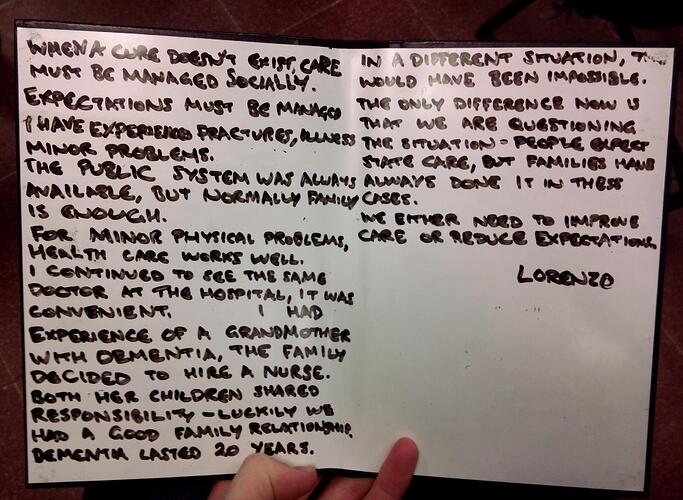Talk to me excercise:
the point of the excercise is that there are some implicit information about care.
The group slit up in 3 people groups
one people ask question
one people answer question
one people is documenting
each session is 20'
Workshop Notes (Contributed by Pauline)
Going from the personal and going global to create
- Common ground (everywhere)
Providing care is providing empowerment for you and the other, helping build steps to autonomy.
Create expectations?
Responsibility?
When does storytelling create empathy? What are the conditions? That it create a connexion to the other person’s circumstances.
Common experiences – if I have been through an experience, am I more equipped to support the other facing that experience?
→ If I was a combatant, I can share my story first then be better equipped to support the combatant I work with.
→ Create a link through storytelling fro better care?
The connexion depends on each particular case – dependency? There is a very personal experience. It is very different when your web of personal experiences are involved.
→ The relationship to distance and care is not as simple; it may be easier to care for someone who is not personally involved.
→ Idea of proximity and whether it is helpful or not
Idea of expectations from a particular context: only support certain things in certain circumstances. You only want to care about certain things at certain times so there is the question of:
- Timing
- Context when shared?
Important concepts for care (therefore to include into storytelling practice):
- Why you help and whether you are more helped yourself.
Burden of care should be spread among people.
Sharing care experiences.
What does this mean for narratives of care?
- Create a context for storytelling.
→ Get to know each other + basic needs?
→ Expectations
→ Communication and identity/sculpture
- Showcase the offer and manage expectations. But how?
→ Communication around culture
→ Storytelling could also be the basis on which you build the context for care.
- Frame it as a tool for empowerment.
- Shared intentions and part of context.
What stories?
- Does the narrative approach scale as well as we think it does?
→ Can you actually bring it global? Yes if you recognize the identity and scaling issue?
- Narrative pattern – ‘imagine a world where…. Oh yeah by the way it already exists…’
- Carriers of narratives – Fiction of narratives, fables, archetypes or a story pattern (David and goliath, or the fool, the hero who goes on a quest). Look at propaganda in the LRA.
→ Are there universal stories?
→ But is it personalized better?
→ Note on George Lucas mythologist
Conclusion:
Space for care includes a variety of aspects that one should balance nut still take action.
- Storytelling as a tool not a universal answer
Passive, Active, Proactive
Give - Receive | Request - response = Communication space around care (actively caring)
They are a lot of difficulties in communicating around care.
Stories – legends - can be a tool to not directly address the issue but rely and build on universal stories.
What then would be 5 steps to design your context of care?
→ Current future vs ideal future
